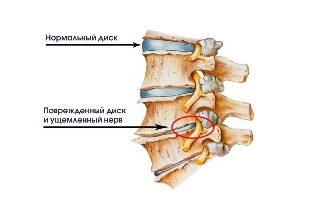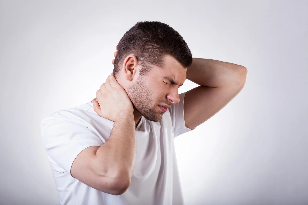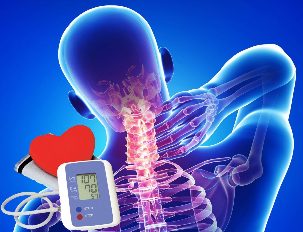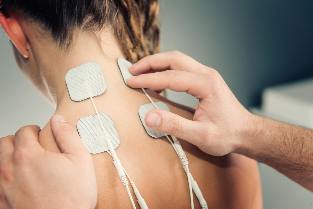Cervical osteochondrosis is a certain dystrophic changes of the intervertebral discs in the neck.

The negative impact affects not only the discs themselves but also the vertebrae, cartilage and soft tissue. The main feature of the cervical spine is the fact that its vertebrae have not the most reliable structure in comparison with other departments, which makes this area very vulnerable. The vertebrae here are located in close proximity to each other and to the arteries, which carry the power of the human brain.
If there is a displacement of the vertebrae, the possibility of compression of nerve fibers and arteries, which will inevitably go to the occurrence of a hernia between vertebrae and protrusion, i.e. changes in the structure of the spinal disc.
What is it?
Osteochondrosis of the cervical spine (Osteohondroz) is a degenerative-dystrophic lesions of the intervertebral discs, which themselves are damaged discs, vertebrae and joints of the cervical, decrease of height of intervertebral discs. The disease progresses if left untreated and can lead to headaches, circulatory problems and even hernia. Like osteoporosis, the disease occurs because of disorders of mineral metabolism, causing bones and joints become less strong.
Osteochondrosis can cause instability of the cervical spine (the symptoms and treatment are similar to the chondrosis, but have a number of features), which is often accompanied by displacement of the vertebrae. In turn, this accelerates the development of degenerative disc disease, destroying the spinal Department.
Stage
The attending physician should determine the degree of development of cervical degenerative disc disease based on medical history and conducting examination of patient. Distinguish only four degrees:
- First degree. The disease is in the Bud, the patient has slight pain in the neck, which can be more intense if the person starts to turn his head.
- Second degree. The patient may complain of very intense pain in the cervical spine, which can be localized in the upper extremities. The clinical picture shows that at this stage of the development of the disease is observed a pinched nerve fibers causing intense pain. It is also noted headache, weakness and General malaise.
- Third degree. The pain becomes almost continuous, radiating also in the shoulder or arm. Some patients diagnosed hernia of the intervertebral discs, which leads to loss of sensation of the upper extremities. During the medical examination there is a noticeable decrease in mobility of the cervical, and pain on palpation.
- Fourth degree. At this stage of the disease the intervertebral disc is almost completely destroyed. In its place there is connective tissue, which leads to deterioration of the patient. He begins to feel pain, noise in the head, and poor orientation in space. This suggests that the artery is clamped, which prevents the natural power of the brain.

Symptoms of degenerative disc disease of the cervical
Important symptoms of degenerative disc disease of the cervical are dizziness, headaches, arterial pressure jumps.
Diagnosis of the disease difficult, sometimes pain is not apparent, and symptoms is erased the character, moreover, uncontrolled use of strong analgesics mask the signs of disease. Patient unable to feel pain, feels healthy, and this continues until the development of irreversible processes in the tissues of the joints of the neck.
Headache in cervical osteochondrosis
This is one of the most common nonspecific signs of many diseases. Headaches are particularly prevalent in the female population. It is difficult to determine the cause of headaches, and, moreover, associate it with the lesions of the spine. There are about 14 different reasons for headache in humans.
The most common causes of headaches with the described pathology:
- Spasms of cerebral vessels;
- A pinched nerve roots;
- A reflex increase in intracranial pressure.
Headache in cervical osteochondrosis can recall the sensation when hypertension, angina or stroke. Especially in middle-aged and older, tend to have the risks of developing strokes or heart attacks.
Feel the pain may be paroxysmal, constant, throbbing, and dull.
When heart diseases patients complain of discomfort in the chest, accompanied by a rhythm disturbance of the heart. To identify the cause only by a qualified doctor. In case of headaches combined with nausea, dizziness and chest pain, made sure the ECG.

Dizziness with cervical osteochondrosis
This condition is not always clearly indicates the degenerative disc disease of the cervical spine.
Dizziness can be the result of:
- Inflammation in the middle or inner ear;
- Spasms of cerebral vessels;
- Violations transmission of nerve impulses;
- Problems with the vestibular apparatus;
- Diseases of the cardiovascular system.
There are no clear criteria dizziness osteochondrosis. However, there are systemic and non-systemic dizziness, they do have distinct differences.
It is recommended to know the differences between systemic and non-systemic dizziness, this will help to determine the causes of unusual States:
- System dizziness is the sensation of circular motion of surrounding objects or body that is a consequence of disruption of the vestibular apparatus, visual analyzers and receptors in joints, muscles and epidermis (low back pain of various etiologies);
- Non-systemic dizziness is a feeling of faintness, feeling stunned, unsure of status in a vertical position. When non-systemic dizziness a feeling of circular rotation is missing, and this is an important difference compared signs.
People who feel the dizziness one of the specified types should be inspected by an experienced doctor, primarily a neurologist or (if there is a suspicion on disease of the ear and throat) an otolaryngologist.
The reason for the emergency hospitalization not related to degenerative disc disease of the cervical spine, is the identification of the patient (except vertigo) such signs as:
- Facial paralysis and numbness of the shoulder belt;
- Severe headache on the background of deterioration of health;
- Violation of coordination of movements;
- The loss or extinction of consciousness.

Blood pressure with cervical osteochondrosis
The relationship of cervical degenerative disc disease with irregular blood pressure has long been established. The cervical vertebrae are important nerve endings and blood vessels.
Characteristic pressure changes during the day. Hypertension for a long time not typical for this disease. Reflex irritation of the nerve endings and the short-term spasms of the blood vessels cause an abrupt diurnal dynamics of arterial hypertension.
A distinctive feature of the increased pressure in cervical osteochondrosis is a combination of the following symptoms:
- Headache;
- Pain in the limbs and chest;
- The reduction of the sensitivity of the neck area;
- The occurrence of pressure peaks after stress, muscle tension, prolonged stay in an uncomfortable position and other similar situations.
These characteristics must be taken into account in the self-differentiation of hypertension of various Genesis.
Spikes HELL and the rapid deterioration of health are the basis for seeking urgent medical assistance.
Syndromes of osteochondrosis
The clinical picture of cervical degenerative disc disease fit into a few syndromes. Syndrome this is multiple symptoms that occur together.
Low back pain consists of the following syndromes:
- Vertebral. It is also called vertebral that indicates that involved in the pathological process of bone and cartilage. This leads to the formation of such symptoms: restriction of motor activity of the neck, pain when it bends, radiographic changes in the picture of the cervical spine. That is the simultaneous appearance of these signs is a vertebral syndrome. A similar set of clinical signs observed in myositis (pathology of muscle tissue) and painful motion, the companion of many other pathologies.
- Syndrome vertebral artery. Appears when the involvement of the vascular bundles, which are responsible for blood flow to the tissues of the Central nervous system. The symptoms suggests that brain tissue has ceased to receive the proper amount of nutrients. How to recognize this syndrome? The first signs are dizziness, feeling of noise in the ears, changes in blood pressure, the emergence of a “veil” before the eyes. This suggests that one of the vertebral arteries is stavlennia condition. Each vessel has its own nerve endings. If you squeeze those that Innervate the vertebral artery will appear headache, numbness, transient loss of vision on one side. In the end, the vascular changes lead to the fact that the brain needs oxygen. At this time, the person feels drowsiness, transient impairment of consciousness, loses focus and control, is worse works and remembers information. With such a clinical picture must be differentiated cervical degenerative disc disease with atherosclerosis of the vertebral arteries, and by compression by a tumor or inflammation.
- Cardiac syndrome. Seen burning in the chest,with dyspnea. Man realizes his frequent palpitations, becomes tired and irritable. This pattern is typical for heart disease for example angina, coronary syndrome, heart attack. The exact conclusion about the causes of such symptoms can be done after the patient undergoes EKG.
- Radicular syndrome. The cervical innervates 8 pairs of nerves, each of which has roots place nerve exit from the spine. Their involvement in osteochondrosis, the patient has reduced sensitivity or Vice versa pain. You may experience numbness of the nape if his soreness, reduced sensation of the tongue, behind the ear, pain in the supraclavicular area. Sometimes there are swallowing disorders, movements in the upper extremities, numbness of the fingers.
First aid in the home during exacerbation of osteochondrosis
When severe pain you can use painkillers such as Analgin, Tempalgin or Baralgin. If the above medicines do not bring relief, you can take NSAIDs (Nise or Diclofenac).
Often used "diversionary" means, for example, the Capsicum plaster that does not heal, but only warms the sore area and distracts from the pain. In the case of formation of edema in the area of inflammation, the patient may drink infusion of herbs or diuretic for 3-4 days. Is it possible to cure osteochondrosis such methods? These measures are only temporary, for treatment reasons, you must contact your doctor.
It should be noted, what doctor treats low back pain. If you suspect that causes of pain in the cervical spine is the occurrence of low back pain, should consult a neurologist. This specialist focuses on diseases of this kind. In some medical institutions are narrowly focused specialists, dealing specifically with diseases of the spine. If your clinic has a spine, you should ask a question how to cure this disease immediately to him.

How to treat osteochondrosis of the cervical?
At the initial stage of development to cure low back pain without drugs, it is enough to revise the diet, daily routine, regularly perform a complex of special exercises. With advanced forms of the disease effective treatment is possible only under condition of application of various medicines which help to delay degenerative changes in the vertebrae.
In the complex of therapeutic measures necessarily include physiotherapy – electrophoresis with drugs, ultrasound, magnetotherapy, laser therapy. These methods help to cope with pain, inflammation, swelling of tissues, improves metabolic processes and blood circulation.
Medication
The main methods of treatment of degenerative disc disease of the cervical spine is medication, physical therapy, massage neck and neck area, particularly effective therapeutic exercises with cervical osteochondrosis. The main groups of drugs used in this disease are:
| Name | The principle of operation |
| Nonsteroidal anti-inflammatory drugs (NSAIDs). Is voltaren, Nise, Movalis, was Ketonal, Ketanov, diclofenac, nimesulide and other | Reduce pain, reduce inflammation and swelling of the spine of the damaged nerve. |
| Drugs that improve blood rheology and blood flow. This aminophylline, trental. | Improve the nutrition of the damaged nerve roots and improves blood flow to the brain. |
| B vitamins Is combilipen, hungama, milgamma, neurobion. | Improve the metabolic processes in the nervous tissue. |
| The muscle relaxants. This mydocalm, sirdalud, chiseled of, tizanidine, etc. | Are drugs that relieve muscle spasm. |
| Chondroprotectors. It (glucosamine and chondroitin) artra, teraflex, doppelgerts, toadstone, Andronova, structovis, alflutop. | It is drugs that restore cartilage tissue, including damaged intervertebral disc. |
By taking a pill of degenerative disc disease, it should be remembered that a significant effect of drug treatment with pills only if combined with other techniques, including exercise. Also it should be noted that the attending physician should appoint than to treat the disease on the basis of its stage and other characteristics.












































